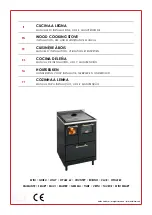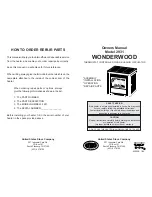
6
The chimney:
All Chimneys should be swept and inspected before installation of any appliance.
For Relining existing chimneys 316 or 904 grade stainless steel liners or pumice cement liners in
accordance with
Building Regulations Approved Document J
should be used. Liners should
be suitably insulated. We recommended that any chimney relining is carried out by an experi-
enced and competent installer who is HETAS registered see www. hetas.co.uk. The HETAS Guide
to Approved products and services lists Chimneys and lining systems suitable for use with solid
fuel.
Hight of chimney
If in doubt, contact your local Chimney Sweeper. He will be able to inform you of the correct
hight.
This stove must not be installed into chimneys that serves any other heating appliance. The
chimney must be a minimum height of 4.5 meters overall height and be in accordance with
HM
Goverment Building Regulations Approved Document J
. Any chimney, either masonry or a
prefabricated stainless steel system must be constructed and installed according to building
regulations. It is recommended that the minimum diameter of the flue liner be 125mm.
For new masonry chimneys we recommend pumice cement liners. A chimney draught of at
least .06” (1.5mm) is recommended.
Make sure the chimney is of a sufficient height, that it draws well and that smoke does not both-
er your neighbours.
We recommend that you fit your chimney with a damper, allowing for draft control. This may
prove particularly important on windy days.
Note: the damper must never shut off draught completely – always allow at least 20 cm² free
passage through the chimney.
With nominal usage the stove has tested a flue gas flow of 4,4
g/second and with a flue gas
temperature of 244
°C.
and at a room temperature of 20 °C.
Varde stoves are always fitted with a smoke plate which redirects smoke to make its way to the
chimney as effectively as possible. This ensures that the heat from the smoke is emitted inside
your home rather than outside it. The smoke plate is moveable and placed in top of the Com-
bustion Chamber. You should make sure that it is pushed all the way back against the back wall
of the combustion chamber.
Draught conditions
Consult your local stove dealer about how best to adjust the draught in your chimney.
Flue Collar
The flue collar is a 5” (125mm) outlet and is supplied pre-assembled on the stove in the vertical
position however, depending on the installation ir may be more appropriate to remove the collar
by removing the two M6 nuts and bolts, rotating it 180 degrees and reattaching the nuts and
bolts which will angle it at 30 degree off the stove. This will help in some installations where for
example clearance is required to clear a lintel. Additionally we are able to supply an offset flue
extension which will position the collar 115mm behind the stove allowing for installations where
the collar needs to be further back.
Sweeping
The chimney should be swept at least once a year for smokeless fuels and a minimum of twice
a year for wood and other fuels. It is important that the flue connection and chimney are swept
prior to lighting up after a prolonged shutdown period. If the stove is fitted in place of an open
fire then the chimney should be swept one month after installation to clear any soot falls which
may have occurred due to the difference in combustion between the stove and the open fire.
In situations where it is not possible to sweep through the stove the installer will have provided
alternative means such as a soot door. After sweeping the chimney, the stove flue outlet and
flue pipe connecting the stove to the chimney must be cleaned with a flue brush.
Summary of Contents for Oslo Series
Page 1: ...1 Installation and User guide Revision 2 Varde Oslo...
Page 17: ...17 Test certificat Smoke Control DEFRA in England NS 3058 3059...
Page 18: ...18 Test certificat from Teknologisk Institut is scanned and placed here...
Page 20: ...20 Kongevej 246 6510 Gram Danmark Tel 45 7482 0003 vardeovne dk...






































